BIOGRAPHY OF CLAUDE MONET (NOVEMBER 14, 1840 - DECEMBER 5, 1926)
Claude Monet was born in Paris on November 14, 1840. By 1845 his family moved to Le Havre, Normandy. Monet showed a great deal of talent from an early age, and in 1851, he enrolled in Le Havre’s secondary school of the arts. As a child, Monet became known locally for his charcoal caricatures that circulated throughout his town.
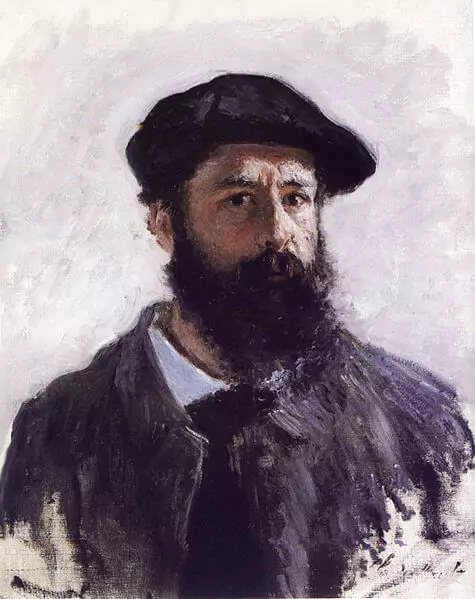
Self Portrait, oil on canvas, 1886

Caricature of a Man

Caricature, Man with Big Cigar

Caricature, Mario Uchard

Auguste Vacquerie
In the mid-1850s, Monet was introduced to Eugene Boudin, who persuaded Monet to paint outdoors. It was at this moment Monet realized his niche for landscape painting and made a practice of painting “en plein air.”
In 1861 Monet’s artistic development came to a halt when the young artist was forced to join the First Regiment of African Light Calvary, and was sent to serve his military duties in Algeria. Within a year of service, Monet became ill with typhoid and was released from service to recuperate. His Aunt was able to pay for his permanent release from military service, and Monet was free to return to painting.

Hunting Trophies
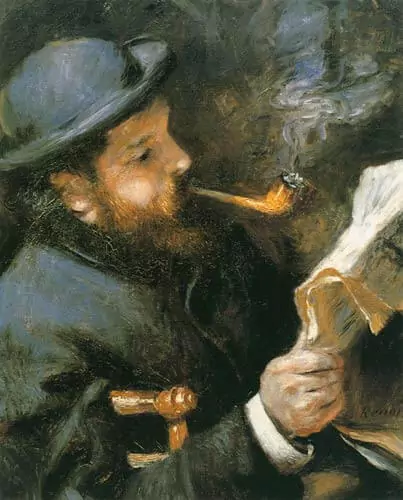
Portrait by Renoir, Monet Reading a Newspaper, 1872
Monet continued his training in Paris, studying under the artist Charles Gleyre. During this time, Monet met Pierre-Auguste Renoir, Frédéric Bazille, and Alfred Sisley. These associations would help him to develop his artistic philosophy and the concept behind Impressionism began to blossom.
The first work to bring him any significant recognition was The Woman in the Green Dress (La Femme à la Robe Verte, 1866), featuring his future wife, Camille Doncieux. Camille later became the subject of many paintings.

The Cradle - Camille with the Artist's Son Jean

The Cradle - Camille with the Artist's Son Jean
Claude and Camille had two sons together, Jean (1868) and Michel (1878). Monet felt the financial stress of raising a family and fell into a state of depression. Shortly after Jean’s birth, Claude attempted suicide by drowning himself.
In 1871, the start of the Franco-Prussian War prompted Monet to leave France and spend a brief period of time in England, where Monet studied the works of John Constable and Joseph Mallord William Turner. The English landscapes become an inspiration to Monet, as he worked to develop his own color palette.

Waterloo Bridge, Gray Weather
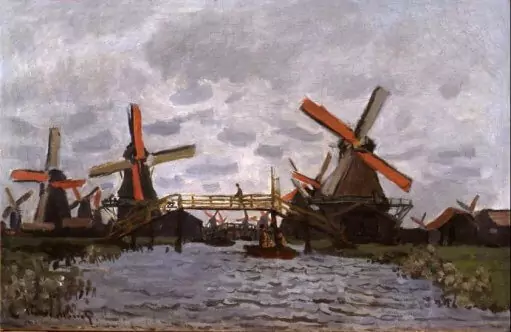
Mills in the Westzjiderveld near Zaandam
Before returning to France in the early 1870s, Monet travelled to Zaandam and Amsterdam. It was here that Monet painted a series of landscape paintings, depicting the iconic Dutch windmills.
After his excursion in the Netherlands, Monet settled in Argenteuil, a French town on the Seine not far from Paris. It was here that Monet executed a pivotal painting: Impression: Sunrise, 1872.

Mills in the Westzjiderveld near Zaandam

Pont d'Argenteuil
Two years later, in 1874, Monet exhibited Impression: Sunrise for the first time in the studio of his friend Nadar. It was from this painting that art critic Louis Leroy coined the term “Impressionism.” While intended as a derogatory label, the independent group of painters forming around Monet quickly adopted the term.

Impression, Sunrise
In 1878, following the birth of his son Michel the Monet family moved into the home of friends Ernest and Alice Hoschedé, in Vétheuil. The following years were filled with a number of unfortunate events. Camille died of tuberculosis, Ernest, who was for a time, a wealthy department store owner, filed bankruptcy and fled to Belgium. Alice moved to Paris to help raise Monet’s children, Jean and Michel, along with her six children.

The Church at Vétheuil

The Artist's Garden at Vétheuil
In 1881, Alice and Monet moved to Poissy with their children. While Monet was not fond of Poissy, he was quite enchanted with the nearby village of Giverny and decided to rent a house in the village, unaware that he would stay in the home for the next forty-three years. The gardens and landscape surrounding the Giverny home became the primary subject matter of Monet’s work from this point on. It was at Giverny that Monet began focusing on his iconic water lily and Japanese footbridge and haystack paintings.
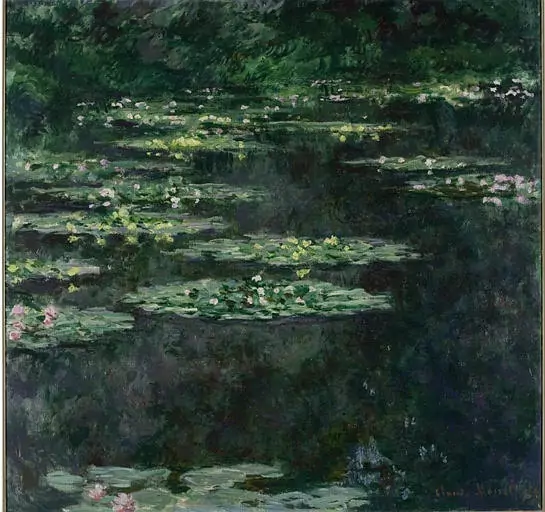
Water Lilies
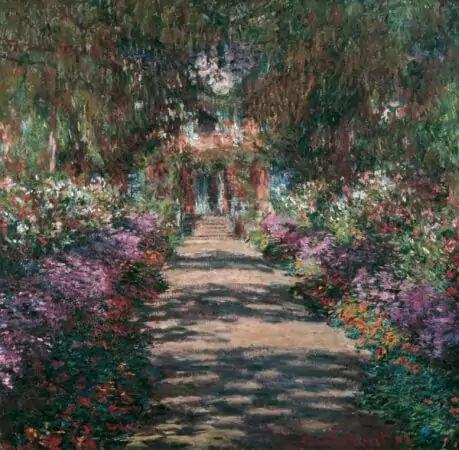
Path in Monet's Garden in Giverny
During the 1880s, Monet’s dealer, Paul Durand-Ruel, began to have more success marketing his work. Sales and exhibitions increased to the point where Monet finally felt some measure of financial security. By 1890, Monet was able to buy the house he was previously only renting in Giverny. Two years later, following the death of Ernest Hoschedé, Monet and Alice were married.
Despite Alice's death in 1911, Alice's and Monet’s children remained close. Monet’s son Jean and Alice’s eldest daughter Blanche eventually married. After the premature death of Jean, Blanche continued to care for her father in law, as Monet suffered from cataracts that nearly brought him to a state of blindness.
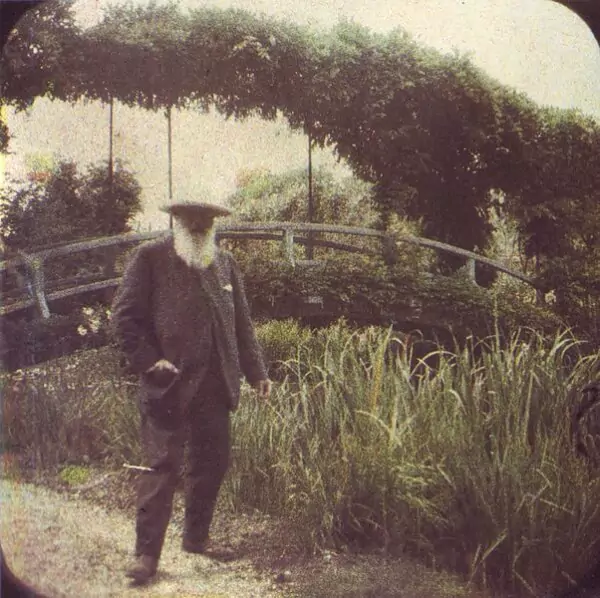
Monet in his Garden at Giverny, 1917
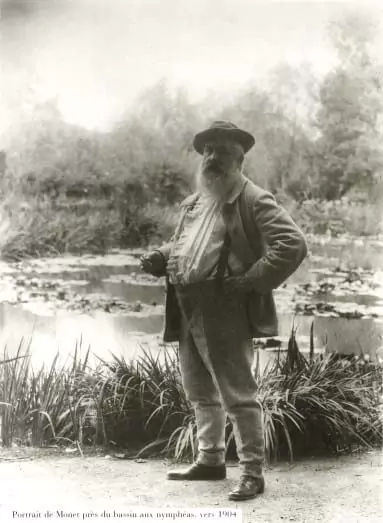
Monet Working on Water Lilies, near end of life
During this time, Monet’s paintings took on a warmer, reddish hue. After his cataract surgery in 1923, his paintings were executed with cooler hues of blue, which can be seen in The Water Lilies.

The Japanese Bridge
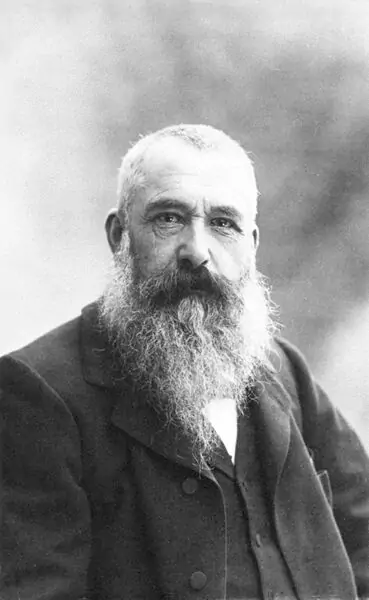
Photo of Monet by Nadar, 1899
Though his vision improved after the surgery, lung cancer began taking its toll on his health. Monet died on December 5, 1926. A small ceremony was held and his remains were interred in a small church cemetery in Giverny.
After Monet’s death, his surviving son, Michel inherited the home and garden in Giverny. Michel bequeathed the grounds to the French Academy of Fine Arts in 1966. A Foundation was soon set up in Monet’s name, and the gardens were restored and opened to the public in 1980. Tourists around the world now visit Giverny year-round to learn about Monet, one of the most influential artists in Modern Art, and the Father of Impressionism.